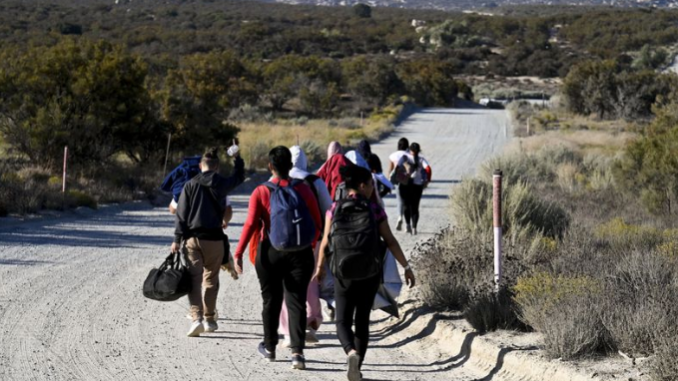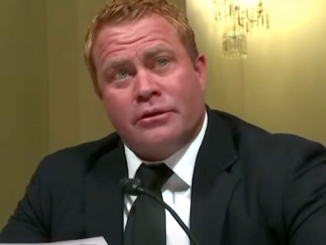
“Gotaways” were first, but the Border Patrol is now corralling “walkaways” — illegal immigrants at the border fence where agents are too overwhelmed to make arrests.
The migrants, sometimes hundreds of them, gather at several spots in Southern California waiting for the agents, but the Biden administration told a federal judge last week that they are “free to leave” whenever they want, meaning they can head back to Mexico or disappear into the U.S.
“They’re walkaways,” said Mark Morgan, who ran Customs and Border Protection in the Trump administration. He said these migrants are yet another indication of the chaos President Biden has ushered in along the nation’s borders. “What’s driving 85% of this crisis is bad policy.”
{snip}
The problem is that the Border Patrol doesn’t have the people or the buses to process and transport the arrivals, who sometimes wait for days.
Agents monitor the migrants, help provide food and water, and conduct crowd control. Single adult men are separated from families and children to try to prevent dangerous situations.
The Border Patrol insists the migrants aren’t in custody, which is why they are free to walk away from the scene.
“Single adult men, like other populations, are free to leave areas where large groups congregate at any point prior to arrest,” Brent L. Schwerdtfeger, the chief of law enforcement operations for the Border Patrol’s San Diego sector, told a federal judge.
The policy was revealed in a court filing for the Flores Settlement, a decades-old agreement that governs how the government treats illegal immigrant children who arrive at the border and, as of 2015, how it treats families.
Flores guarantees a certain level of care, including food, bedding, and safe and comfortable detention conditions while illegal immigrants await release or transfer to other agencies.
{snip}
The Biden administration says these migrants haven’t been put through a field interview and aren’t under arrest, so they are free to leave and the government has no obligation.
A judge will hear arguments on that question this week.
Whatever the legal issues, the result is a horror for those stuck waiting, said volunteers who have visited the sites.
One doctor who visited in December called the sites “apocalyptic.”
Dr. Theresa Chang reported responding to the case of a 13-year-old boy who was apparently in a car accident in Mexico. In the U.S., he was bleeding through his nose and ears and was showing signs of heart trouble.
She started performing CPR but said two Border Patrol agents did not attempt to help. Emergency services arrived after an hour, and the boy died in a hospital.
She said a man had severe ankle pain and was stuck lying on the ground for days without assistance.
Another volunteer reported to the court that children had hypothermia from being left out overnight in the desert. Other migrants said they had to sleep in the dirt and were pestered by scorpions and snakes.
Mr. Schwerdtfeger said agents provide some assistance, such as snacks and water. A paid contractor picks up trash and sets up portable toilets and hand-washing stations.
{snip}
He said agents last year issued colored wristbands as part of a triage system. The bands told agents which migrants had been waiting longest and which ones, such as the elderly, families or pregnant women, were priorities for arrest and processing.
He indicated that practice ended in December.
He didn’t say why, but Mr. Morgan offered one possibility: Issuing the bands might cross the line into an arrest, which would trigger the Flores obligations.
The court documents don’t say how many migrants have walked away from the sites, which are labeled open-air detention sites, or OADS.
CBP declined to answer questions for this report, citing the ongoing Flores case.
The walkaways are similar to gotaways — migrants who cross into the country illegally but whom agents are unable to catch. They are considered the most worrying cases because agents never get even a moment’s encounter.
Gotaways are a symptom of the border chaos. The more agents pulled from the front lines to process people, the more openings for migrants.
Yet walkaways may be a more damning critique because agents have them in their grasp and have to let them disappear.
Mr. Morgan said agents have two bad choices: They can grab more personnel from the front lines and deploy them to process the groups, which means even more gotaways, or they can accept that they are knowingly letting migrants disappear.
“It’s a lesser of the two evils,” he said. “Either take all the resources to make sure no one leaves, leaving other areas even more wide open, or do the best to process as fast as you can so the chances are fewer will walk away, knowing some are going to walk away.”
He demurred when asked whether the current prioritization was the right call.
{snip}
Attorneys for the Flores families and children say they are in custody, no matter what the government says, and are not free to leave.
“CBP agents tell noncitizens to wait in the OADS and people follow those orders,” Mishan Wroe, one of the plaintiffs, said in a court filing.
San Diego is the westernmost of nine sectors the Border Patrol maintains on the southwest border. The sector is divided into eight stations, including Boulevard Station, which includes 10 linear miles of border, and Imperial Beach Station, with 5½ miles.
Both areas have a border wall and some have a secondary wall, creating what agents call an enforcement zone between them.
The idea is that someone in Mexico can make it over the first wall because nobody tries to stop them on the southern side. They then have to make it over the second wall on the U.S. side. In the time it takes to clear the second wall, agents can respond and arrest them.
Under Mr. Biden, however, large groups show up and migrants don’t even try to clear the second wall. They plop down and wait to be arrested and processed by Border Patrol agents, figuring they have good chances of being caught and released.
Mr. Schwerdtfeger said the migrants were following directions from smuggling cartels, who picked the spots where the migrants were told to wait.
{snip}
From March through December last year, the Imperial Beach Station made more than 71,000 arrests. Boulevard Station and neighboring Campo Station, which helps when the situation gets overwhelming, made more than 96,000 arrests, including 20,400 in December alone.
* Original Article:
https://www.washingtontimes.com/news/2024/mar/25/agents-in-california-say-some-illegal-immigrants-w/?utm_source=smartnews.com&utm_medium=smartnews&utm_campaign=smartnews%20
